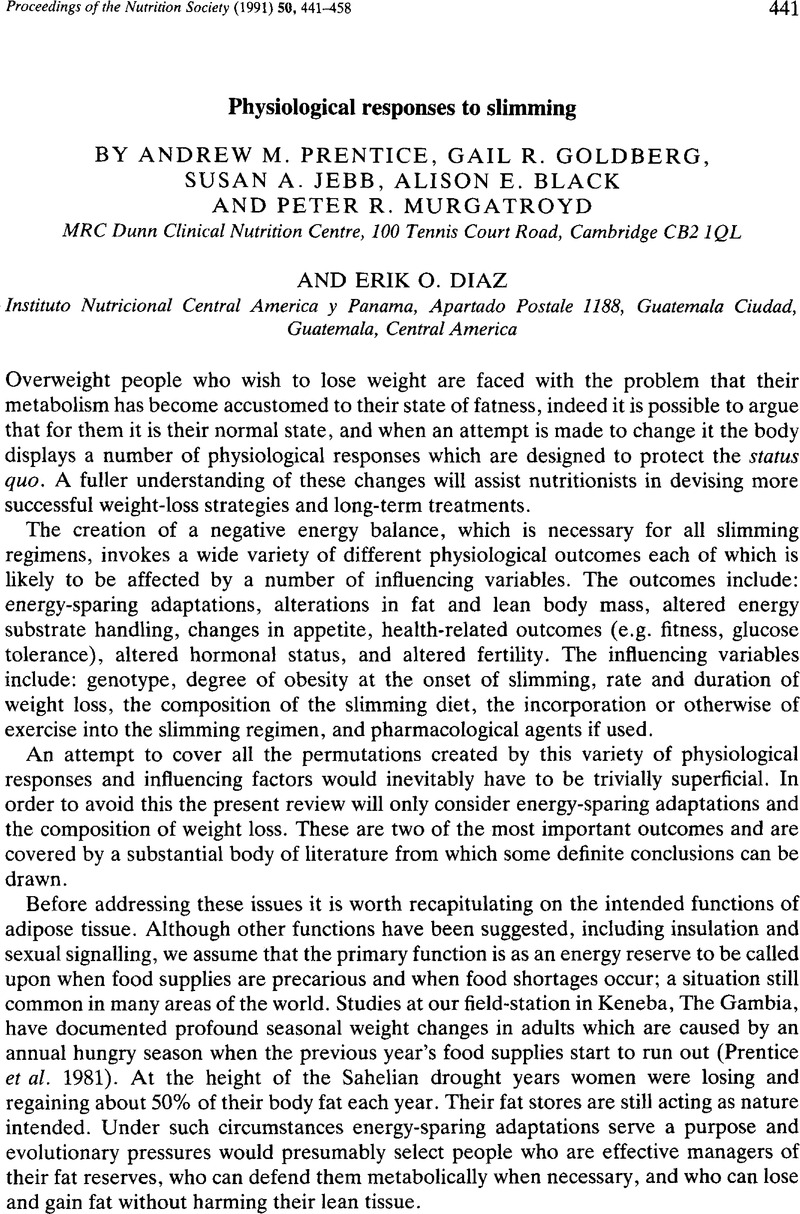Crossref Citations
This article has been cited by the following publications. This list is generated based on data provided by Crossref.
Prentice, AM
Jebb, SA
Goldberg, GR
Coward, WA
Murgatroyd, PR
Poppitt, SD
and
Cole, TJ
1992.
Effects of weight cycling on body composition.
The American Journal of Clinical Nutrition,
Vol. 56,
Issue. 1,
p.
209S.
Hill, Andrew J.
1993.
Pre-Adolescent Dieting: Implications for Eating Disorders.
International Review of Psychiatry,
Vol. 5,
Issue. 1,
p.
87.
Hill, Andrew J.
1993.
Causes and consequences of dieting and anorexia.
Proceedings of the Nutrition Society,
Vol. 52,
Issue. 1,
p.
211.
Karklin, A
Driver, HS
and
Buffenstein, R
1994.
Restricted energy intake affects nocturnal body temperature and sleep patterns.
The American Journal of Clinical Nutrition,
Vol. 59,
Issue. 2,
p.
346.
J.M. Velthuis-te Wierik, Erica
and
Berg, Henk van den
1994.
Energy restriction, the basis for successful aging in man?.
Nutrition Research,
Vol. 14,
Issue. 7,
p.
1113.
Vigus, Jane
Tata, Philip
Judd, Pat
Bowyert, Carole
and
Evans, Elizabeth
1995.
Which way to treat obesity? Emotional, eating and behavioural issues in dieting.
Journal of Human Nutrition and Dietetics,
Vol. 8,
Issue. 2,
p.
105.
Jebb, Susan A.
1995.
Weight Control.
p.
48.
Jenike, Mark R.
1995.
Variation in body fat and muscle mass: Responses to seasonal hunger among tropical horticulturists, Zaire.
Ecology of Food and Nutrition,
Vol. 34,
Issue. 3,
p.
227.
Ballor, Douglas L.
and
Poehlman, Eric. T.
1995.
A meta-analysis of the effects of exercise and/or dietary restriction on resting metabolic rate.
European Journal of Applied Physiology and Occupational Physiology,
Vol. 71,
Issue. 6,
p.
535.
Westerterp, Klaas R.
Donkers, Jeroen H. H. L. M.
Fredrix, Elisabeth W. H. M.
and
oekhoudt, Piet
1995.
Energy intake, physical activity and body weight: a simulation model.
British Journal of Nutrition,
Vol. 73,
Issue. 3,
p.
337.
Jenike, Mark R.
1996.
Activity reduction as an adaptive response to seasonal hunger.
American Journal of Human Biology,
Vol. 8,
Issue. 4,
p.
517.
Butterwick, R. F.
and
Markwell, P. J.
1996.
Changes in the body composition of cats during weight reduction by controlled dietary energy restriction.
Veterinary Record,
Vol. 138,
Issue. 15,
p.
354.
Dulloo, A. G.
1997.
Human pattern of food intake and fuel-partitioning during weight recovery after starvation: A theory of autoregulation of body composition.
Proceedings of the Nutrition Society,
Vol. 56,
Issue. 1A,
p.
25.
PRITCHARD, JANET E.
NOWSON, CARYL A.
and
WARK, JOHN D.
1997.
A Worksite Program for Overweight Middle-Aged Men Achieves Lesser Weight Loss With Exercise Than With Dietary Change.
Journal of the American Dietetic Association,
Vol. 97,
Issue. 1,
p.
37.
Jebb, Susan A.
1997.
From chemical analysis of the body...to metabolic insights provided by the new methodology.
British Journal of Nutrition,
Vol. 78,
Issue. s2,
p.
S101.
Henry, Christiani Jeyakumar
Payne, Philip R
and
Ghusain-Choueiri, Amal
1997.
Relationship between tissue mobilization and storage in the rat .
British Journal of Nutrition,
Vol. 78,
Issue. 1,
p.
131.
Fredrix, Elisabeth W.�H.�M.
Staal-van den Brekel, Agnes J.
and
Wouters, Emiel F.�M.
1997.
Energy balance in nonsmall cell lung carcinoma patients before and after surgical resection of their tumors.
Cancer,
Vol. 79,
Issue. 4,
p.
717.
Carbonnel, F
Messing, B
Rimbert, A
Rongier, M
Koziet, J
and
Darmaun, D
1997.
Energy and protein metabolism during recovery from malnutrition due to nonneoplastic gastrointestinal disease.
The American Journal of Clinical Nutrition,
Vol. 65,
Issue. 5,
p.
1517.
Shimamoto, Hideki
Adachi, Yukio
Takahashi, Michiyo
and
Tanaka, Kiyoji
1998.
Low Impact Aerobic Dance as a Useful Exercise Mode for Reducing Body Mass in Mildly Obese Middle-Aged Women..
APPLIED HUMAN SCIENCE Journal of Physiological Anthropology,
Vol. 17,
Issue. 3,
p.
109.
Butterwick, Richard F.
and
Hawthorne, Amanda J.
1998.
Advances in Dietary Management of Obesity in Dogs and Cats.
The Journal of Nutrition,
Vol. 128,
Issue. 12,
p.
S2771.



